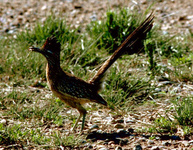

Roadrunner. Courtesy US Fish and Wildlife
The Roadrunner is the most famous bird in the Sonoran desert. They are specifically known for their swift movements and their star role in the Roadrunner and Coyote cartoon. They eat mostly small animals such as small birds and snakes, and can run fast enough to catch and eat rattlesnakes! The Roadrunner's scientific name is Geococcyx californianus. They are very interesting birds!
The roadrunner is an unusual looking bird. They have a long upright body with a long tail that sticks almost straight up. Their head is an oval shape with a long straight black beak. Their feathers are usually a brownish black with white stripes and spots. Their feathers are sleek and laid back. They usually weigh about 8-24 ounces and their length is usually about 20-24 inches. Roadrunners usually stand around 10-12 inches high. Their feet are zygodactyl, which means two toes point forward, and two point backwards.
Roadrunners have about 7 different calls. Their normal noise is a cooing noise.
Range
You can usually find Roadrunners in parts of Colorado, Kansas, Oklahoma, Arkansas, New Mexico, Arizona, and southward into Mexico.
Enemies
Roadrunners find lots of bigger animals as threats to them. These include raccoons, bobcats, hawks, and coyotes.
Roadrunner Facts
- Roadrunners are fast enough to catch and kill a rattlesnake
- Roadrunners can run up to 17 miles per hour
- The Roadrunner is also known as the Chapparral Cock
- Roadrunners are a part of the Cuckoo family
- The Roadrunner's nasal gland eliminates excess salt, instead of using the urinary tract, like most other birds
- The roadrunner is the state bird of New Mexico
- The Roadrunner prefers walking or running places, and they rarely fly. If they do fly it's for short distances
- The Roadrunner is very adaptable and can control its own body temperature
- The Roadrunner is non-migratory
Other
The Roadrunner's mating season is in the springtime. They usually have about 2-12 eggs. The Roadrunner's lifespan is normally anywhere from 7 to 8 years and their typical diet includes insects, small rodents, fruits, seeds, lizards and snakes. They are able to catch snakes up to two feet long!



 Go to quick links
Go to quick search
Go to navigation for this section of the ToL site
Go to detailed links for the ToL site
Go to quick links
Go to quick search
Go to navigation for this section of the ToL site
Go to detailed links for the ToL site